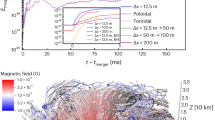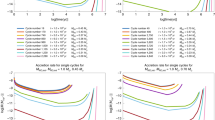Abstract
Classical novae1,2 are thermonuclear explosions in binary stellar systems containing a white dwarf accreting material from a close companion star. They repeatedly eject 10−4–10−5 solar masses of nucleosynthetically enriched gas into the interstellar medium, recurring on intervals of decades to tens of millennia. They are probably the main sources3,4 of Galactic 15N, 17O and 13C. The origin of the large enhancements and inhomogeneous distribution of these species observed in high-resolution spectra5 of ejected nova shells has, however, remained unexplained for almost half a century6. Several mechanisms7, including mixing by diffusion8, shear9 or resonant gravity waves10, have been proposed in the framework of one-dimensional or two-dimensional simulations, but none has hitherto proven successful because convective mixing can only be modelled accurately in three dimensions. Here we report the results of a three-dimensional nuclear-hydrodynamic simulation of mixing at the core–envelope interface during nova outbursts. We show that buoyant fingering drives vortices from the Kelvin–Helmholtz instability, which inevitably enriches the accreted envelope with material from the outer white-dwarf core. Such mixing also naturally produces large-scale chemical inhomogeneities. Both the metallicity enhancement and the intrinsic dispersions in the abundances are consistent with the observed values.
This is a preview of subscription content, access via your institution
Access options
Subscribe to this journal
Receive 51 print issues and online access
$199.00 per year
only $3.90 per issue
Buy this article
- Purchase on Springer Link
- Instant access to full article PDF
Prices may be subject to local taxes which are calculated during checkout


Similar content being viewed by others
References
Bode, M. F. & Evans, A. eds. Classical Novae 2nd edn (Cambridge Univ. Press, 2008)
Hernanz, M. & José, J. eds. Classical Nova Explosions (AIP, 2002)
José, J., Hernanz, M. & Iliadis, C. Nucleosynthesis in classical novae. Nucl. Phys. A 777, 550–578 (2006)
Starrfield, S., Iliadis, C. & Hix, W. R. in Classical Novae 2nd edn (eds Bode, M. F. & Evans, A. ) 77–101 (Cambridge Univ. Press, 2008)
Gehrz, R. D., Truran, J. W., Williams, R. E. & Starrfield, S. Nucleosynthesis in classical novae and its contribution to the interstellar medium. Publ. Astron. Soc. Pacif. 110, 3–26 (1998)
José, J. & Shore, S. N. in Classical Novae 2nd edn (eds Bode, M. F. & Evans, A. ) 121–140 (Cambridge Univ. Press, 2008)
Shore, S. N., Livio, M. & van den Heuvel, E. P. J. Interacting Binaries (Springer, 1994)
Prialnik, D. & Kovetz, A. The effect of diffusion on prenova evolution—CNO-enriched envelopes. Astrophys. J. 281, 367–374 (1984)
Kutter, G. S. & Sparks, W. M. Stellar accretion of matter possessing angular momentum. Astrophys. J. 321, 386–393 (1987)
Rosner, R., Alexakis, A., Young, Y.-N., Truran, J. W. & Hillebrandt, W. On the C/O enrichment of nova ejecta. Astrophys. J. 562, L177–L179 (2001)
Porter, J. M., O’Brien, T. J. & Bode, M. F. On the asphericity of nova remnants caused by rotating white dwarf envelopes. Mon. Not. R. Astron. Soc. 296, 943–948 (1998)
Vaytet, N. M. H., O’Brien, T. J. & Rushton, A. P. Evidence for ablated flows in the shell of the nova DQ Herculis. Mon. Not. R. Astron. Soc. 380, 175–180 (2007)
Shore, S. N., Starrfield, S., Ake, T. B., III & Hauschildt, P. H. Spatially resolved spectra of V1974 Cygni (Nova Cygni 1992) with the Goddard High Resolution Spectrograph. Astrophys. J. 490, 393–400 (1997)
Gehrz, R. D. in Classical Novae 2nd edn (eds Bode, M. F. & Evans, A. ) 167–193 (Cambridge Univ. Press, 2008)
McLaughlin, D. B. The behaviour of absorption systems in spectra of novae. Annls Astrophys. 27, 450–461 (1964)
Starrfield, S., Truran, J. W., Sparks, W. M. & Kutter, G. S. CNO abundances and hydrodynamic models of the nova outburst. Astrophys. J. 176, 169–176 (1972)
Glasner, S. A. & Livne, E. Convective hydrogen burning down a nova outburst. Astrophys. J. 445, L149–L151 (1995)
Glasner, S. A., Livne, E. & Truran, J. W. Reactive flow in nova outbursts. Astrophys. J. 475, 754–762 (1997)
Kercek, A., Hillebrandt, W. & Truran, J. W. Two-dimensional simulations of the thermonuclear runaway in an accreted atmosphere of a C+O white dwarf. Astron. Astrophys. 337, 379–392 (1998)
Glasner, S. A., Livne, E. & Truran, J. W. The sensitivity of multidimensional nova calculations to the outer boundary condition. Astrophys. J. 625, 347–350 (2005)
Glasner, S. A., Livne, E. & Truran, J. W. Novae: the evolution from onset of convection to the runaway. Astrophys. J. 665, 1321–1333 (2007)
Casanova, J., José, J., García-Berro, E., Calder, A. & Shore, S. N. On mixing at the core–envelope interface during classical nova outbursts. Astron. Astrophys. 513, L5 (2010)
Casanova, J., José, J., García-Berro, E., Calder, A. & Shore, S. N. Mixing in classical novae: a 2-D sensitivity study. Astron. Astrophys. 527, A5 (2011)
Kercek, A., Hillebrandt, W. & Truran, J. W. Three-dimensional simulations of classical novae. Astron. Astrophys. 345, 831–840 (1999)
Arnett, D., Meakin, C. & Young, P. A. Turbulent convection in stellar interiors. II. The velocity field. Astrophys. J. 690, 1715–1729 (2009)
Pope, S. B. Turbulent Flows (Cambridge Univ. Press, 2000)
Shore, S. N. Astrophysical Hydrodynamics: An Introduction (Wiley, 2007)
Fryxell, B. A. & Woosley, S. E. Finite propagation time in multidimensional thermonuclear runaways. Astrophys. J. 261, 332–336 (1982)
Fryxell, B. et al. FLASH: an adaptive mesh hydrodynamics code for modeling astrophysical thermonuclear flashes. Astrophys. J. 131 (Suppl.). 273–334 (2000)
Zingale, M. et al. Mapping initial hydrostatic models in Godunov codes. Astrophys. J. 143 (Suppl.). 539–565 (2002)
Acknowledgements
The software used in this work was developed in part by the Department of Energy-supported Alliances Center for Astrophysical Thermonuclear Flashes at the University of Chicago. This work was partly supported by Spanish Ministerio de Educación y Ciencia grants, by the Agència de Gestió d'Ajuts Universitaris i de Recerca of the Generalitat de Catalunya, by the E.U. European Fund for Regional Development, and by the European Science Foundation EUROCORES Program EuroGENESIS. We also acknowledge the Barcelona Supercomputing Center for allocation of time at the MareNostrum supercomputer.
Author information
Authors and Affiliations
Contributions
All authors contributed equally to the results presented here.
Corresponding author
Ethics declarations
Competing interests
The authors declare no competing financial interests.
Supplementary information
Supplementary Information
This file contains Supplementary Text, which describes Supplementary Movies 1 and 2. This file was replaced on 14 November 2011. (PDF 40 kb)
Supplementary Movie 1
This movie shows a two-dimensional slice of the time evolution of the 12C abundance, in logarithmic scale, at the core-envelope interface during a nova outburst on a 1 solar mass CO white dwarf that accretes solar composition matter. (MOV 25326 kb)
Supplementary Movie 2
This movie shows a two-dimensional slice of the time evolution of the 15O abundance, in linear scale, at the core-envelope interface during a nova outburst on a 1 solar mass CO white dwarf that accretes solar composition matter. (MOV 25362 kb)
PowerPoint slides
Rights and permissions
About this article
Cite this article
Casanova, J., José, J., García-Berro, E. et al. Kelvin–Helmholtz instabilities as the source of inhomogeneous mixing in nova explosions. Nature 478, 490–492 (2011). https://doi.org/10.1038/nature10520
Received:
Accepted:
Published:
Issue Date:
DOI: https://doi.org/10.1038/nature10520
This article is cited by
-
Elemental abundances in novae
Journal of Astrophysics and Astronomy (2021)
-
A unified theory of cataclysmic variable evolution from feedback-dominated numerical simulations
Nature Astronomy (2020)
-
Laboratory evidence for co-condensed oxygen- and carbon-rich meteoritic stardust from nova outbursts
Nature Astronomy (2019)
-
Mixed messages from a nova outburst
Nature Astronomy (2019)
-
Observatory science with eXTP
Science China Physics, Mechanics & Astronomy (2019)
Comments
By submitting a comment you agree to abide by our Terms and Community Guidelines. If you find something abusive or that does not comply with our terms or guidelines please flag it as inappropriate.



